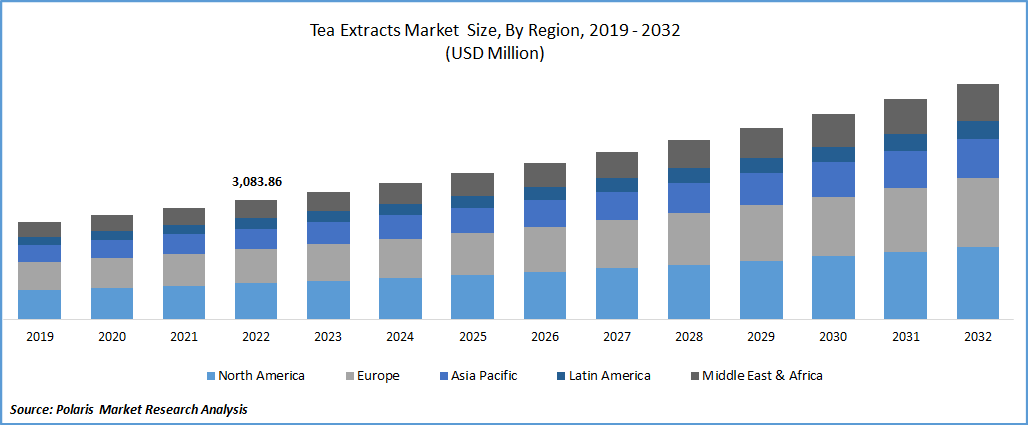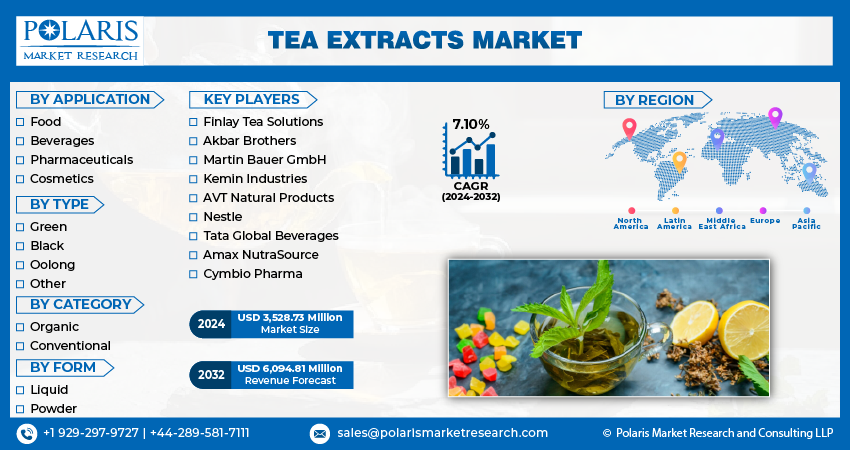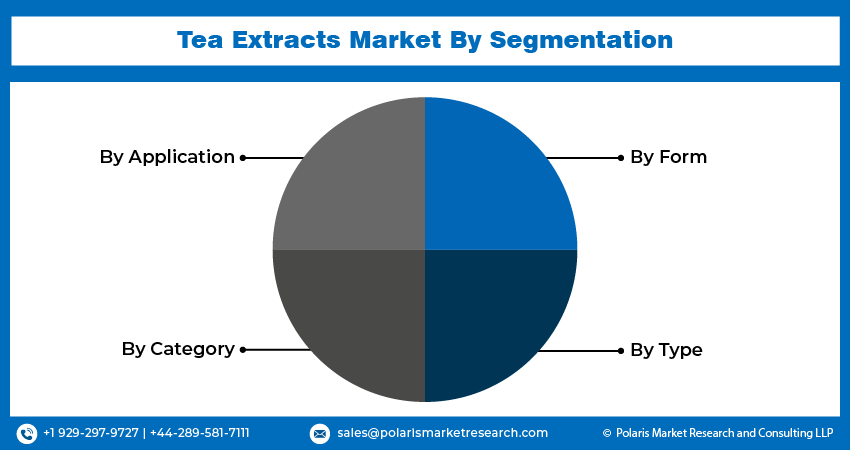
Tea Extracts Market Size, Share, & Industry Analysis Report
: By Application (Food, Beverages, Pharmaceuticals, and Cosmetics), By Category, By Form, By Type, and By Region – Market Forecast, 2025–2034
- Published Date:Aug-2025
- Pages: 120
- Format: pdf
- Report ID: PM3026
- Base Year: 2024
- Historical Data: 2020-2023
Market Overview
The tea extracts market size was valued at USD 2,784.94 million in 2024, growing at a CAGR of 7.7% during 2025–2034. The market growth is primarily fueled by rising health consciousness among consumers and rising applications of tea extracts in dietary supplements and cosmetics.
Key Insights
- The beverages segment dominates the market, primarily fueled by the rising consumption of tea worldwide.
- The organic segment is anticipated to register the highest growth rate during the projection period. This is primarily due to growing consumer preference for organically sourced products.
- The powder segment accounts for a larger market share, owing to the various benefits associated with powder extracts.
- Asia Pacific accounts for the largest market share due to the region’s long-standing tradition of tea consumption.
- North America exhibits considerable market presence. The regional market growth is fueled by growing demand for natural ingredients in dietary supplements, foods, and beverages.
Industry Dynamics
- Increasing awareness and focus on health and wellness, which has prompted consumers to seek products with natural ingredients, drives the demand for tea extracts.
- The shift towards natural and clean-label products in the food & beverage industry is another factor fueling market demand.
- Expanding applications of tea extracts in cosmetics and personal care are expected to create several market opportunities in the coming years.
- High production costs of tea extracts may hinder market growth.
Market Statistics
2024 Market Size: USD 2,784.94 million
2034 Projected Market Size: USD 5,833.92 million
CAGR (2025-2034): 7.7%
Asia Pacific: Largest Market in 2024

To Understand More About this Research: Request a Free Sample Report
The tea extracts market comprises concentrated substances derived from tea leaves, such as green tea, black tea, and oolong tea. These extracts are rich in antioxidants and bioactive compounds, making them highly sought after in various industries, including food and beverages, pharmaceuticals, dietary supplements, and personal care. The increasing consumer demand for natural and functional ingredients is a primary driver for the market expansion. Tea extracts are used as natural flavor enhancers and functional ingredients with health benefits, such as antioxidants. The growing consumption of ready-to-drink teas and functional beverages globally has significantly contributed to the demand for tea extracts, as these beverages are perceived as healthier alternatives to sugary drinks.
The rising health consciousness among consumers is driving the demand for tea extracts, as the extracts are known for their antioxidant properties and potential role in improving metabolism. The growing demand for clean-label and natural ingredients in the food & beverage industry and the increasing applications of tea extracts in dietary supplements, functional beverages, and cosmetics contribute to the demand for tea extracts. The popularity of green tea extracts, known for their high polyphenol content and association with weight management and skincare, is also on the rise.
Market Dynamics
Rising Health Consciousness Among Consumers
The increasing awareness and focus on health and wellness among consumers globally drive the demand for tea extracts. People are actively seeking out products with natural ingredients and potential health benefits, and tea extracts fit this demand perfectly. Green tea extracts, in particular, are recognized for their high concentration of antioxidants, such as catechins, which have been linked to various health advantages. The demand for functional foods and beverages, which often incorporate health-promoting ingredients such as tea extracts, is on the rise, with the US market for these growing significantly. This growing consumer preference for health-enhancing ingredients is creating a strong demand for tea extracts across different applications, from beverages to dietary supplements, thereby fueling the tea extracts market growth.
Growing Demand for Natural and Clean Label Ingredients
The food & beverages industry trends indicate a strong shift toward natural and clean-label products. Consumers are increasingly wary of artificial additives and synthetic ingredients, preferring products made with natural sources. Tea extracts, being derived directly from tea leaves, align perfectly with this preference. They offer a natural way to add flavor, color, and functional benefits to various products without the need for artificial substances. A research article published in the journal Food Chemistry on ScienceDirect in 2022, "Natural food additives, preservatives, and processing aids from plants: Global market analysis and future perspectives," highlights the rising demand for plant-based extracts as natural alternatives in the food industry. The rising preference for natural ingredients is significantly boosting the demand for tea extracts as manufacturers reformulate their products to meet consumer expectations, thus driving the tea extracts market development.
Expanding Applications Across Various Industries
The versatility of tea extracts and their expanding applications across multiple industries serve as a crucial growth factor. The extracts are increasingly being incorporated into dietary supplements, functional foods such as functional protein, cosmetics, and even pharmaceuticals due to their beneficial properties. For instance, their antioxidant and anti-inflammatory properties make them valuable in skincare formulations. A study published in the International Journal of Molecular Sciences on MDPI in 2021, "The Role of Green Tea Polyphenols in Photoprotection," discusses the potential of green tea extracts in protecting the skin against UV radiation. This diversification of applications across various sectors is contributing substantially to the overall tea extracts market expansion.

Segment Insights
Market Assessment – By Application
The tea extracts market, by application, is segmented into food, beverages, pharmaceuticals, and cosmetics. The beverages segment holds the largest share. This dominance is primarily attributed to the widespread consumption of tea-based drinks globally, including ready-to-drink teas, iced teas, and other flavored tea beverages. Tea extracts are favored for their ability to impart natural flavor and color, as well as provide inherent health benefits associated with tea consumption. The increasing preference for healthier beverage options over sugary, carbonated, and energy drinks further solidifies the beverages segment's leading position. The ease of incorporating tea extracts into various beverage formulations and the strong consumer appeal of tea-based drinks contribute significantly to the substantial share held by this application.
The pharmaceuticals segment is anticipated to exhibit the highest growth rate during the forecast period. This rapid growth is driven by the increasing recognition of the therapeutic potential of tea extracts, particularly green tea extracts, due to their rich antioxidant and anti-inflammatory properties. Ongoing research continues to explore the applications of tea extracts in preventing and managing various health conditions, leading to their increased incorporation in pharmaceutical formulations and nutraceutical products. The rising consumer interest in natural remedies and preventative healthcare, coupled with advancements in extraction and formulation technologies, is expected to fuel the pharmaceutical applications of tea extracts in the coming years. This expanding utilization in health-related products positions the pharmaceuticals segment as the one with the most promising growth trajectory in the market.
Market Evaluation – By Category
By category, the tea extracts market is segmented into organic and conventional. The conventional segment accounts for a larger share. This dominance is primarily attributed to the established agricultural practices and the widespread availability of conventionally grown tea leaves, which have historically been the primary source for tea extract production. The well-established supply chain and the generally lower production costs associated with conventional farming have contributed to the larger volume of conventional tea extracts available in the market. This has allowed for greater market penetration across various application industries, solidifying the conventional segment's leading position.
The organic segment is projected to experience the highest growth rate during the forecast period. This accelerated growth is fueled by the increasing consumer preference for organically sourced products, driven by rising concerns regarding pesticide residues and environmental sustainability. As awareness about the potential health and ecological benefits of organic farming grows, the demand for organic tea extracts is also on the rise. This trend is particularly evident in health-conscious consumer segments and in applications such as dietary supplements and natural cosmetics, where organic certification is highly valued. The increasing investments in organic farming practices and the expanding availability of organic tea leaves are expected to further propel the growth of the organic tea extracts segment in the coming years.
Market Evaluation – By Form
The tea extracts market, by form, is segmented into liquid and powder. The powder segment holds a larger share. Powder extracts offer advantages such as ease of handling, longer shelf life, and convenient incorporation into a wide range of applications, including dry mixes, capsules, and tablets in the food, beverage, and pharmaceutical industries. The stability and versatility of powder form tea extracts make them a preferred choice for manufacturers, contributing to their dominant market presence. The established manufacturing processes and widespread use of powder extracts across various end-use sectors further reinforce their leading position.
The liquid segment is anticipated to exhibit a higher growth rate during the forecast period. This growth is driven by the increasing demand for liquid extracts in the beverage industry, particularly for ready-to-drink teas and other liquid formulations where direct incorporation is more straightforward. Liquid extracts can offer a more natural and fresh perception to consumers in certain applications. Furthermore, advancements in extraction technologies that allow for the production of high-quality liquid extracts with concentrated bioactive compounds are also contributing to the segment's growth. The rising popularity of convenience and ready-to-use formats, especially in the beverage sector, positions the liquid form as the segment with the most promising growth prospects in the tea extracts market.
Market Evaluation – By Type
The tea extracts market, by type, is segmented into green, black, oolong, and other. The green tea extract segment holds the largest share. This is primarily due to the well-documented health benefits associated with green tea, including its high antioxidant content and potential role in weight management and disease prevention. The widespread consumer awareness and demand for these health-promoting properties have led to the extensive use of green tea extracts across various applications, including beverages, dietary supplements, and cosmetics. The strong scientific backing and positive consumer perception of green tea contribute significantly to its leading position.
The oolong tea extract segment is anticipated to exhibit the highest growth rate during the forecast period. While not as widely consumed as green or black tea, oolong tea is gaining recognition for its unique flavor profile and potential health benefits, which are somewhat intermediate between green and black tea. Increased research into the specific bioactive ingredients and compounds present in oolong tea and their potential health impacts is driving greater interest in oolong tea extracts. Furthermore, the growing demand for novel and specialty tea flavors in the beverage industry is contributing to the rising popularity and anticipated high growth rate of the oolong tea extract segment in the coming years.

Regional Analysis
The tea extracts market report demonstrates a global presence, with key regions including North America, Europe, Asia Pacific, Latin America, and the Middle East & Africa. Each region is contributing uniquely to the overall market dynamics. Asia Pacific represents a significant region in terms of both consumption and production of tea, thus holding a substantial portion of the tea extracts industry share. North America and Europe also exhibit considerable market presence, driven by the increasing demand for natural ingredients in food, beverages, and dietary supplements. Latin America and the Middle East & Africa are emerging regions with growing potential for tea extract applications. The demand trends are influenced by regional consumer preferences, regulatory landscapes, and the penetration of various end-use industries across these geographies.
Asia Pacific holds the largest share and the highest growth rate. The regional market growth is attributed to the region's long-standing tradition of tea consumption and its position as a major producer of tea leaves. Countries within Asia Pacific have a high demand for tea-based products, and the well-established food and beverage industries in this region extensively utilize tea extracts as natural ingredients. Furthermore, the increasing health awareness among the large population base in Asia Pacific drives the demand for tea extracts in dietary supplements and functional foods. The expanding applications of tea extracts in various sectors, coupled with a strong domestic supply of tea leaves, create a favorable environment for market development. Additionally, the continuous innovation in product formulations incorporating tea extracts and the increasing market penetration in developing economies in Asia Pacific are anticipated to fuel the market growth in the region during the forecast period.

Key Players and Competitive Insights
A few of the major players active in the tea extracts market include Martin Bauer Group; Finlays (John Swire & Sons Ltd); Indena S.p.A.; Taiyo Kagaku Co., Ltd.; AVT Natural Products Limited (OmniActive Health Technologies); Verdant Health Australia Pty Ltd; FutureCeuticals, Inc.; Layn Natural Ingredients Corp.; Nutra Green Biotechnology Co., Ltd.; Hunan NutraMax Inc.; and Sabinsa Corporation.
The competitive landscape of the tea extracts industry is characterized by a mix of established global players and smaller, specialized companies. Competition is based on factors such as product innovation, quality, cost-effectiveness, and the ability to cater to specific application requirements. Companies are focusing on expanding their product portfolios to include a wider range of tea extracts, including organic and specialty extracts, and investing in research and development to explore new applications and health benefits. Strategic partnerships, collaborations, and expansions in key regional markets are also common strategies employed by players to enhance their market penetration and strengthen their position.
Martin Bauer Group, headquartered in Vestenbergsgreuth, Germany, offers a comprehensive range of tea extracts, including green tea, black tea, and specialty tea extracts. Their offerings cater to the food and beverage, dietary supplement, and pharmaceutical industries, providing standardized extracts and customized solutions. They maintain a significant presence in the market due to their extensive experience in plant-based ingredients and a strong focus on quality and sustainability.
Finlays, part of John Swire & Sons Ltd and based in London, UK, is a prominent player in the tea industry with a wide portfolio of tea extracts. Their offerings include various forms of tea extracts, such as liquid and powder, suitable for beverage applications, flavorings, and natural ingredients in other sectors. With a long history in tea processing and a global supply chain, Finlays holds a strong position in supplying tea extracts to a diverse customer base.
List of Key Companies
- AVT Natural Products Limited (OmniActive Health Technologies)
- Finlays (John Swire & Sons Ltd)
- FutureCeuticals, Inc.
- Hunan NutraMax Inc.
- Indena S.p.A.
- Layn Natural Ingredients Corp.
- Martin Bauer Group
- Nutra Green Biotechnology Co., Ltd.
- Sabinsa Corporation
- Taiyo Kagaku Co., Ltd.
- Verdant Health Australia Pty Ltd
Tea Extracts Industry Developments
- December 2024, Givaudan (Switzerland) unveiled its advanced Cultured Hub biotech center, designed to accelerate sustainable food innovation. Equipped with modern labs for product development, fermentation, and scale-up processes, the center supported faster market readiness. It aimed to transform the tea extract industry by improving plant cell cultivation, refining extraction methods, and fostering innovation in tea-based products.
Tea Extracts Market Segmentation
By Application Outlook (Revenue – USD Million, 2020–2034)
- Food
- Beverages
- Pharmaceuticals
- Cosmetics
By Category Outlook (Revenue – USD Million, 2020–2034)
- Organic
- Conventional
By Form Outlook (Revenue – USD Million, 2020–2034)
- Liquid
- Powder
By Type Outlook (Revenue – USD Million, 2020–2034)
- Green
- Black
- Oolong
- Other
By Regional Outlook (Revenue – USD Million, 2020–2034)
- North America
- US
- Canada
- Europe
- Germany
- France
- UK
- Italy
- Spain
- Netherlands
- Russia
- Rest of Europe
- Asia Pacific
- China
- Japan
- India
- Malaysia
- South Korea
- Indonesia
- Australia
- Rest of Asia Pacific
- Middle East & Africa
- Saudi Arabia
- UAE
- Israel
- South Africa
- Rest of Middle East & Africa
- Latin America
- Mexico
- Brazil
- Argentina
- Rest of Latin America
Tea Extracts Market Report Scope
|
Report Attributes |
Details |
|
Market Size Value in 2024 |
USD 2,784.94 million |
|
Market Size Value in 2025 |
USD 2,992.42 million |
|
Revenue Forecast by 2034 |
USD 5,833.92 million |
|
CAGR |
7.7% from 2025 to 2034 |
|
Base Year |
2024 |
|
Historical Data |
2020–2023 |
|
Forecast Period |
2025–2034 |
|
Quantitative Units |
Revenue in USD million and CAGR from 2025 to 2034 |
|
Report Coverage |
Revenue Forecast, Competitive Landscape, Growth Factors, and Industry Insights |
|
Segments Covered |
|
|
Regional Scope |
|
|
Competitive Landscape |
|
|
Report Format |
|
|
Customization |
Report customization as per your requirements with respect to countries, regions, and segmentation. |
How is the report valuable for an organization?
Workflow/Innovation Strategy
The tea extracts market has been segmented into detailed segments of application, category, form, and type. Moreover, the study provides the reader with a detailed understanding of the different segments at both the global and regional levels.
Market Entry Strategies
A key growth strategy for the market revolves around emphasizing the natural and health-enhancing properties of these ingredients to health-conscious consumers. Marketing efforts should highlight the scientific evidence supporting the antioxidant benefits and potential applications in functional foods, beverages, and dietary supplements. Collaborations with food and beverage manufacturers to develop innovative products featuring tea extracts as a key ingredient can also drive market penetration.
FAQ's
The market size was valued at USD 2,784.94 million in 2024 and is projected to grow to USD 5,833.92 million by 2034.
The market is projected to register a CAGR of 7.7% during the forecast period.
North America held the largest share of the market in 2024.
A few of the major players currently active in the tea extracts market are Martin Bauer Group; Finlays (John Swire & Sons Ltd); Indena S.p.A.; Taiyo Kagaku Co., Ltd.; AVT Natural Products Limited (OmniActive Health Technologies); Verdant Health Australia Pty Ltd; FutureCeuticals, Inc.; Layn Natural Ingredients Corp.; Nutra Green Biotechnology Co., Ltd.; Hunan NutraMax Inc.; and Sabinsa Corporation.
The beverages segment accounted for the largest share of the market in 2024.
Following are a few of the market trends: ? Increasing Demand for Natural and Clean Label Ingredients: Consumers are actively seeking products with natural origins and minimal artificial additives, driving the demand for tea extracts as natural flavorants, colorants, and functional ingredients. ? Rising Health and Wellness Awareness: Growing consumer focus on health and well-being is boosting the popularity of tea extracts due to their antioxidant properties and potential health benefits.
Tea extracts are concentrated substances derived from the leaves of the Camellia sinensis plant, the same plant that is used to make brewed tea. These extracts contain a high concentration of the beneficial compounds found in tea, such as polyphenols (including catechins like EGCG), caffeine, and amino acids.
